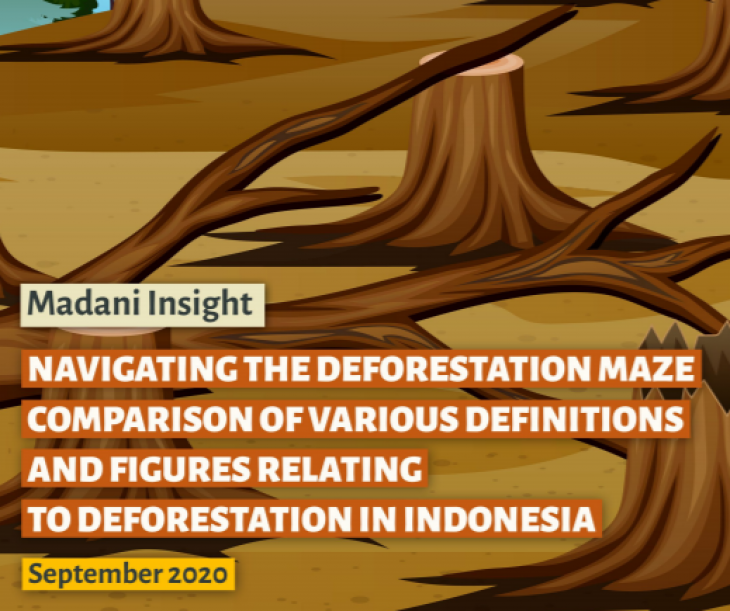NAVIGATING THE DEFORESTATION MAZE COMPARISON OF VARIOUS DEFINITIONS AND FIGURES RELATING TO DEFORESTATION IN INDONESIA
09/06/2023

In this paper, Madani compares the definitions of forest, deforestation, degradation, methodologies of calculating deforestation, and finally, deforestation figures from the following institutions: the Food and Agriculture Organization (FAO), the Ministry of Environment and Forestry (MoEF), and several Civil Society Organizations (CSO) while highlighting points of contentions among these institutions.
In defining forests, one of the main points of contention is the minimum limit of tree cover to be called forest, namely between 10 to 30%.
Another point of contention is the categorization of timber plantation as forest. CSOs in this study argue that timber plantation should not be included in the forest land class/category because they are monoculture and more akin to a plantation rather than biodiverse forest. CSOs fear that the inclusion of timber plantations to forest land class will conceal destruction of natural forests to make way to timber plantations, especially Industrial Timber Plantation, which is one of the main drivers of the natural forests’ loss in Indonesia.
Another point of contention is the dichotomy of natural forests into primary and secondary forests, in which the protection of secondary forests is weaker than primary natural forests. CSOs in this study are pushing for indiscriminate protection of natural forests without dichotomizing them into primary and secondary natural forests, especially in the context of halting new permits permanently.
The next point of contention highlighted in this study pertains to different definitions of primary forest used by the MoEF (Ministry of Environment and Forestry) and GFW (Global Forest Watch). GFW uses a broader definition for primary forests with deforestation values close to the overall value of natural forest deforestation coming from the MoEF.
When defining deforestation, some CSOs oppose the use of ‘net deforestation’ that has been used and highlighted by the government of Indonesia in their official public communications. Aside from the fact that the loss of forests in one area cannot be replaced by forest replanting in other areas due to the functions they serve, CSOs fear that this definition will conceal the destruction of natural forests converted into timber plantations, especially Industrial Timber plantations.
READ ALSO: Madani Insight Mengurai Benang Kusut Deforestasi
Related to deforestation figures, the number of natural forest loss between 2006-2018 published by the MoEF is much lower than the number published by FWI (Forest Watch Indonesia). The MoEF data show a declining trend in terms of gross deforestation and the loss of natural forest in the period of 2006-2018. In contrast, FWI data show an increasing trend in the rate of natural forest loss in the same period.
For 3 periods (2011-2012, 2012-2013, and 2013-2014), the rate of natural forest loss published by the MoEF was close to the primary forest loss figures published by GFW. Both data sets from MoEF and GFW show a declining trend in terms of natural forest loss during the 2006-2018 period. However, while MoEF shows a declining trend in terms of gross deforestation in 2006-2018, the Tree Cover Loss data from GFW shows an opposing trend in the 2006-2018 period, keeping in mind that the definition of ‘Tree Cover Loss’ and ‘deforestation’ are not interchangeable.
When cross-examining spatial and statistical data published by MoEF, Madani’s analysis confirmed the MoEF’s data consistency in terms of gross deforestation. However, the consistency of natural forest loss and net deforestation data could not be confirmed due to limited access of natural forest loss and reforestation data.
Lastly, there are unanswered questions about the different definition of natural forest loss used by the MoEF in the Deforestation Book and in constructing FREL for REDD+. The study found that the rates of natural forest loss used in FREL construction are higher than the ones cited in the Deforestation Book for the following periods: 2006-2009, 2009-2011, and 2011-2012 where data were available.
To navigate the deforestation maze, different institutions that possess and produce different data and conclusions regarding the number and trends of deforestation need to sit together and publicly expose their methodology and sources to provide clearer information for the public regarding the current status and condition of Indonesia’s forests and to put more objectivity in assessing Indonesia’s success in reducing deforestation.
Get more about Madani Insight “Navigating The Deforestation Maze Comparison of Various Definitions And Figures Relating to Deforestation In Indonesia” by downloading the available report.
Silahkan download file yang berkaitan dibawah ini: